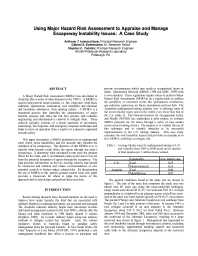Mining Publication: Using Major Hazard Risk Assessment to Appraise and Manage Escapeway Instability Issues: A Case Study
Original creation date: July 2007
A Major Hazard Risk Assessment (MHRA) was developed in Australia after a series of mine disasters in the 1990's. A MHRA is used to help prevent major hazards, i.e. fire, explosion, wind-blast, outbursts, spontaneous combustion, roof instability and chemical and hazardous substances, from injuring miners. A MHRA is a structured process that identifies the characteristics of major hazards, assesses and ranks the risk they present, and evaluates engineering and administrative controls to mitigate them. These controls typically consists of a broad spectrum of prevention, monitoring, first response, and emergency response techniques and helps to move an operation from a reactive to a proactive approach towards safety. This paper documents a MHRA performed at an underground mine where strata instabilities and fire hazards may threaten the condition of its escapeways. The objective of this MHRA is to 1) identify what hazards could affect the egress through the mine’s escapeways, 2) determine what unwanted events pose the greatest threat for the mine, and 3) recommend a plan to prevent or recover from the potential disruption of egress through the escapeway. The plan provides information on the key existing controls that should be monitored and audited, and makes recommendation of new potential controls to further reduce related risks. By documenting the use of MHRA to this specific ground control issue, this paper provides a framework for others to judge the merits of this approach and to help design and perform these activities.
Authors: AT Iannacchione, GS Esterhuizen, SC Tadolini
Conference Paper - July 2007
NIOSHTIC2 Number: 20032440
Proceedings of the 26th International Conference on Ground Control in Mining, July 31 - August 2, 2007, Morgantown, West Virginia. Peng SS, Mark C, Finfinger G, Tadolini S, Khair AW, Heasley K, Luo Y, eds., Morgantown, WV: West Virginia University, 2007; :354-360
See Also
- Assessing and Monitoring Open Pit Mine Highwalls
- Defining Risk Perception and Tolerance Within a Decision Science Framework
- Focus on Prevention: Conducting a Fire Risk Assessment
- Major Hazard Risk Assessment Applied to Pillar Recovery Operations
- Mapping Hazards with Microseismic Technology to Anticipate Roof Falls - A Case Study
- Practical Risk Assessment Guidelines for Identifying, Assessing, and Mitigating Stored Energy Hazards in Underground Coal Mines During and After a Mine Emergency
- SPONCOM - A Computer Program for the Prediction of the Spontaneous Combustion Potential of an Underground Coal Mine
- SponCom - Spontaneous Combustion Assessment Software - 2.0
- Technology News 545 - NIOSH Updates Spontaneous Combustion Assessment Software
- Toolbox Training For Construction Aggregate Miners
- Page last reviewed: 9/21/2012
- Page last updated: 9/21/2012
- Content source: National Institute for Occupational Safety and Health, Mining Program


 ShareCompartir
ShareCompartir
